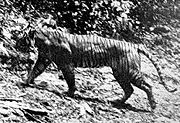Javan Tiger
| Javan tiger | ||||||||||||||||
|---|---|---|---|---|---|---|---|---|---|---|---|---|---|---|---|---|
 A well known picture of a Javan tiger (1938)
|
||||||||||||||||
| Conservation status | ||||||||||||||||
|
Critically endangered, possibly extinct |
||||||||||||||||
| Scientific classification | ||||||||||||||||
|
||||||||||||||||
| Trinomial name | ||||||||||||||||
| Panthera tigris sondaica (Temminck, 1844) |
||||||||||||||||
 Javan tiger range map
|
The Javan tiger (Panthera tigris sondaica) was a tiger limited to the Indonesian island of Java. It now seems likely that this subspecies was made extinct in the 1980s, as a result of hunting and habitat destruction, but the extinction of this subspecies became increasingly probable from the 1950s onwards, when it is thought that fewer than 25 tigers remained in the wild. The last specimen was sighted in 1972. A track count in 1979 concluded that three of the tigers were in existence. It is possible that a small population of tigers continues to exist on West Java, as there were unverified sightings in the 1990s.[1] [2]
Contents |
Javan tiger reserves
By 1940, the Javan tiger had been pushed into remote mountain ranges and forests. Some small reserves were set up, but were not large enough, and the quantity of prey species were too low. By the mid-1950s, 20-25 tigers remained on Java. Half of these were in the well-known Ujong Kulon Wildlife Reserve, but the 1960s saw all tigers eliminated from this area and also from Baluran National Park. By 1972, the Javan tiger count was down to a maximum of seven in the newly-formed Meru Betiri Forest Reserve, and perhaps five elsewhere. Meru Betiri was rugged and considered this tiger's last chance for survival. However, even as it was declared a reserve, the area was under attack by agricultural development. A 1979 census located the tracks of only three tigers. Substantiated evidence that this tiger is still alive has not been forthcoming since then. The exact time of extinction remains unknown, but this was probably sometime in the mid-1980s.[3]
Physical Description
Javan tigers were very small compared to other subspecies. Males were between 100 kg (220 lb) and 141 kg (310 lb) on average and around 2.45 m (8.0 ft) in length. Females weighed between 75 kg (170 lb) and 115 kg (250 lb) on average and are smaller than males in length.
Continued sightings of the Javan tiger
Occasional reports still surface of a few tigers to be found in east Java where the forested areas account for almost thirty percent of the land surface. Meru Betiri National Park, the least accessible area of the island, is located here and considered the most likely area for any remaining Javan tigers. This park is now coming under threat from three gold mining companies after the discovery of 80,000 tons of gold deposit within the locality.
Despite the continuing claims of sightings it is far more likely that, even with full protection and in reserve areas, the Javan tiger was unable to be saved. The 'tigers' are quite likely to be leopards seen from a distance.
At the present time the World Conservation Monitoring Centre lists this subspecies as having an 'outstanding query over status' rather than 'extinct', and some agencies are carrying out experiments using infrared activated remote cameras in an effort to photograph any tigers. Authorities are even prepared to initiate the move of several thousand people should tiger protection require this.
But until concrete evidence can be produced (expert sightings, pug marks, photographic evidence, attacks on people and animals), the Javan tiger must be considered yet another tiger subspecies which is probably extinct.[4]
On November 2008, an unidentified body of a female mountain hiker was found in Mount Merbabu National Park, Central Java, allegedly died from tiger attack. Villagers who discovered the body has also claimed some tiger sightings in the vicinity. [5]
See also
- Trinil Tiger
- Sumatran Tiger
- Bali Tiger
References
- ↑ Bambang M. 2002. In search of 'extinct' Javan tiger. The Jakarta Post (October 30).
- ↑ Harimau jawa belum punah! (Indonesian Javan Tiger website)
- ↑ Annabell, M. "The Javan Tiger". Tiger Territory - The Internet's most massive information and tiger photograph resource. 2001
- ↑ Save The Tiger Fund - The Javan Tiger
- ↑ http://www.detiknews.com/read/2008/11/17/191947/1038555/10/pendaki-wanita-tewas-di-gunung-merbabu-diduga-diterkam-harimau
|
|||||||||||||||||||||||||||||||||||||||||||||||||||